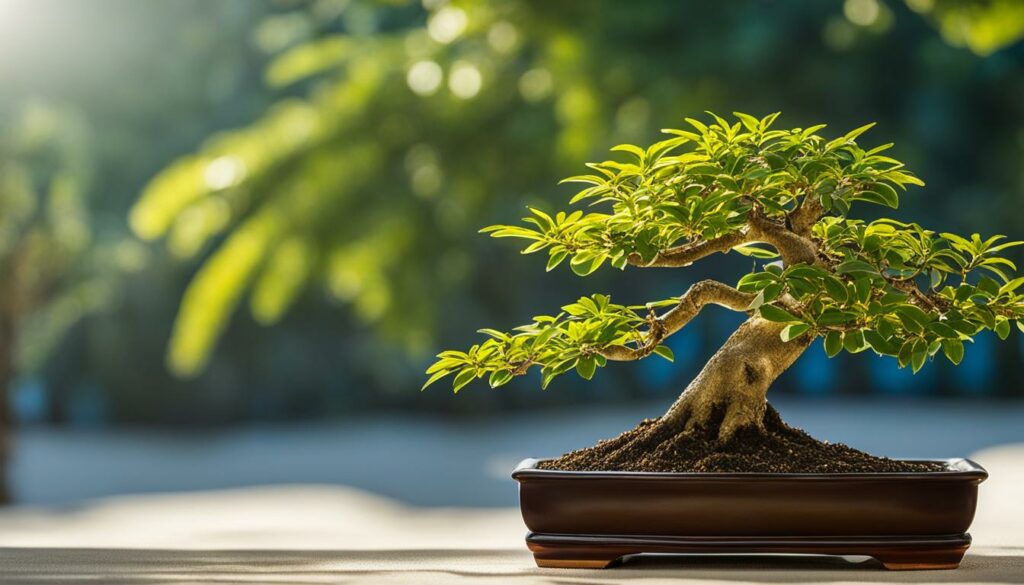Discover the beauty and elegance of the Sageretia Theezans, also known as the Chinese sweet plum, a popular choice among indoor bonsai enthusiasts. In this article, you will learn about the unique characteristics of the Sageretia Theezans and its essential care tips to ensure its thriving growth.
Key Takeaways:
- The Sageretia Theezans is a beautiful and popular bonsai tree species.
- It is also known as the Chinese sweet plum and has unique characteristics such as delicate white flowers and small leaves.
- To ensure its growth and health, it is important to choose the right location, maintain proper watering and humidity levels, prune and shape, fertilize correctly and prevent or treat pests and diseases.
- The Sageretia Theezans is a symbol of peace, harmony, and tranquility, making it a rewarding bonsai tree species to cultivate.
- By following proper care techniques, you can enjoy the full potential of this remarkable bonsai tree.
Introduction to Sageretia Theezans
If you’re looking for a beautiful and graceful bonsai tree species, then the Sageretia Theezans is an excellent option. This lovely tree species goes by many names, including the Chinese sweet plum, and is a popular choice among bonsai enthusiasts.
The Sageretia Theezans is native to China and is part of the Rhamnaceae family. Its foliage consists of small, delicate leaves and stunning white flowers that bloom in the summertime, adding an enchanting touch to its appearance.
When grown indoors, this bonsai tree species can thrive and is an excellent choice for those looking to create an indoor oasis. The Sageretia Theezans is also relatively easy to care for, making it ideal for beginners.
Why Sageretia Theezans is a Popular Choice Among Bonsai Enthusiasts
The Sageretia Theezans is popular among bonsai enthusiasts for many reasons. Not only does it have an elegant and graceful appearance, but it’s also relatively easy to cultivate and maintain. This bonsai tree species is a great option for anyone who wants to add a touch of serenity to their indoor environment.
Another reason why this bonsai tree species is so popular is its compact growth habit, making it perfect for small spaces. Additionally, the Sageretia Theezans can be easily shaped and pruned to maintain its beautiful form and encourage its growth.
“The Sageretia Theezans adds a beautiful aura of tranquility to any indoor space. It’s no surprise why it’s one of the most sought-after bonsai tree species.”
Characteristics of Sageretia Theezans
Get ready to be enchanted by the unique characteristics of the Sageretia Theezans, a stunning bonsai tree species that is perfect for your indoor oasis. This Chinese sweet plum is admired for its graceful growth habit, shaped by its delicate branches and beautiful foliage. The small, shiny green leaves create a charming contrast to the smooth, silver bark, adding to its visual appeal.
But the beauty does not end there! The Sageretia Theezans also produces lovely white flowers that create a magical, serene atmosphere. The flowers usually appear in the early summer or late spring, providing a beautiful complement to the lush greenery.
As an indoor bonsai, the Sageretia Theezans adapts well to a variety of environments and can be cultivated in small spaces. Its ability to create an enchanting aura in indoor settings is praised by bonsai enthusiasts, making it a popular choice for those who seek to add a touch of elegance and tranquility to their homes.
Highlighted by its graceful form and delicate appearance, the Sageretia Theezans is a bonsai tree species that is sure to leave a lasting impression on anyone who beholds its beauty.
Choosing the Right Location for Your Sageretia Theezans
Proper location is crucial for your Sageretia Theezans bonsai tree to thrive. Select an indoor spot that gets bright but indirect sunlight. Direct sunlight can scorch the delicate leaves and flowers. You can also use a fluorescent light to supplement natural light if necessary.
The ideal temperature for your Sageretia Theezans is between 60 and 75 degrees Fahrenheit (15-24°C). Avoid placing the tree near drafty areas, such as doors or windows, or near heating or cooling vents.
Humidity is essential for the health of your Sageretia Theezans bonsai tree. It can benefit from a humidity level between 40-50%. To maintain the required humidity levels, you can keep a tray filled with pebbles and water beneath the tree. The evaporating water creates a humid environment that promotes healthy growth. You can also use a humidifier to regulate the humidity levels.
Note: Keep your Sageretia Theezans bonsai tree away from cold drafts, hot air vents, or any other factors that may cause sudden changes in temperature or humidity.
Watering and Humidity for Sageretia Theezans
Proper watering and humidity levels are vital to the health and vitality of your Sageretia Theezans indoor bonsai tree.
Watering
It’s crucial to avoid overwatering your Sageretia Theezans, as this can lead to root rot and other plant diseases. On the other hand, underwatering can cause the tree to wither and die. To ensure proper watering, wait until the top layer of soil feels slightly dry before watering. Use a watering can or spray bottle to gently moisten the soil, and be sure to drain any excess water from the pot.
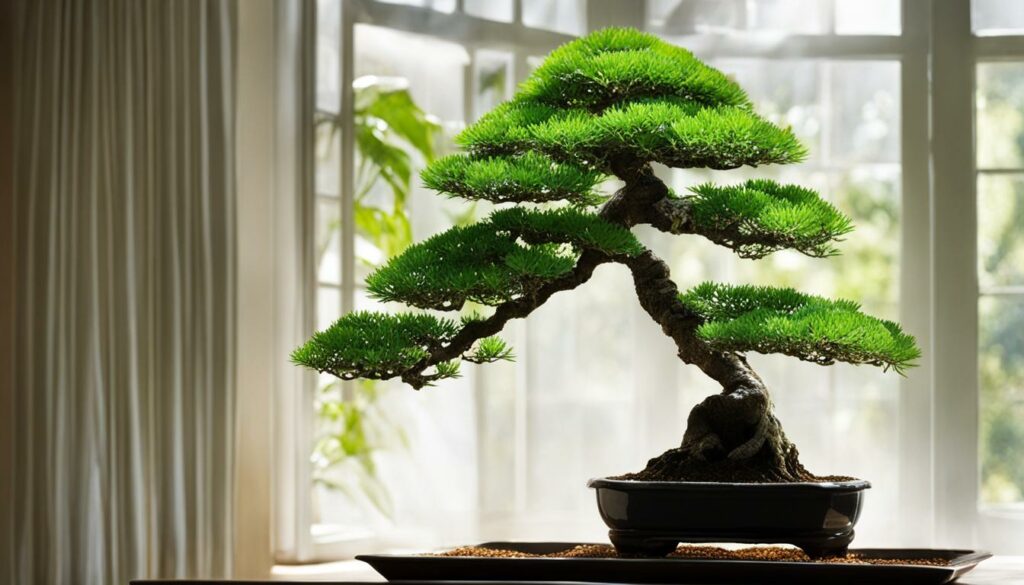
Humidity
The Sageretia Theezans bonsai tree thrives in moderately humid environments, which can be challenging to achieve in most indoor settings. To maintain a suitable level of humidity, consider using a humidifier or a pebble tray filled with water beneath the tree. Misting the leaves with water can also enhance humidity levels, but be sure not to overwater the tree in the process.
Pruning and Shaping Sageretia Theezans
Pruning and shaping your Sageretia Theezans bonsai tree is an art that requires patience and skill. Proper pruning techniques will help maintain the elegant form of your bonsai tree and encourage compact growth. Here are some tips to help you achieve the best results:
- Know when to prune: Pruning is best done during the winter or early spring, before new growth appears. Avoid doing it during the summer or fall.
- Use the right tools: A sharp, clean pair of scissors or pruning shears is essential for a clean cut and to prevent damage to the tree.
- Remove dead or damaged branches: Prune any dead or damaged branches to maintain the health of your bonsai tree.
- Balance the branches: Prune branches and twigs to balance the tree and promote radial symmetry.
- Encourage new growth: Prune back to a bud or leaf to encourage new growth and maintain the shape of the tree.
- Wiring: Wiring can also be used to shape and train your bonsai tree into the desired form.
Proper pruning and shaping techniques will not only maintain the beauty of your Sageretia Theezans bonsai tree but also encourage its healthy growth.
Fertilizing Sageretia Theezans
Proper fertilization is crucial to the health and growth of your Sageretia Theezans bonsai tree. Fertilizing provides the essential nutrients that your tree needs to thrive.
You should fertilize your Sageretia Theezans bonsai tree once a month during the growing season, from spring to fall. Use a balanced fertilizer, such as a 10-10-10 formula, and dilute it to half-strength to avoid over-fertilizing your tree.
When applying fertilizer, it’s important to follow the instructions carefully, as the amount and frequency of fertilizer application may vary depending on the specific product.
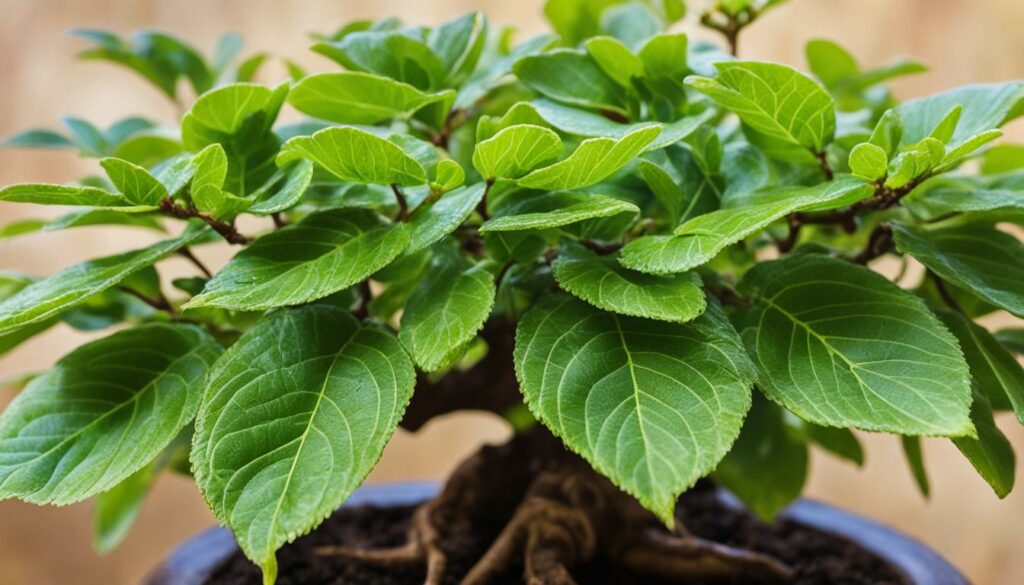
Keep in mind that over-fertilizing your Sageretia Theezans bonsai tree can lead to fertilizer burn, which can cause damage to your tree’s roots and ultimately affect its health. Therefore, it’s essential to avoid applying too much fertilizer and stick to the recommended dosage.
By fertilizing your Sageretia Theezans bonsai tree with the right nutrients, you can help promote its vigorous growth and ensure a healthy and beautiful tree.
Dealing with Pests and Diseases
When caring for your Sageretia Theezans bonsai tree, it’s essential to keep an eye out for common pests and diseases that can damage its health and beauty.
Common pests that could attack your bonsai tree include scale insects, spider mites, and aphids. Signs of pest infestation include black or brown discoloration of leaves and stems, as well as the presence of sticky residue on the tree. To prevent and treat infestations, you can regularly inspect your tree, isolate it from other plants, and use safe insecticides that are suitable for indoor bonsai trees.
Diseases such as root rot and powdery mildew can also cause harm to your bonsai tree. Root rot is usually caused by overwatering and poor drainage, which can lead to fungal growth that affects the roots. To prevent root rot, use well-draining soil and avoid overwatering. Powdery mildew appears as a white powdery substance on the leaves and can be treated by removing affected areas and improving air circulation around the tree.
Remember, a healthy and well-cared-for Sageretia Theezans bonsai tree is less likely to succumb to pests and diseases. So, regular pruning, proper watering, and fertilization are crucial to maintaining its beauty and vitality.
Sageretia Theezans: A Symbol of Serenity
The Sageretia Theezans bonsai tree embodies the essence of peace, harmony, and tranquility. This lovely bonsai tree species, also known as the Chinese sweet plum, is a favorite among indoor bonsai enthusiasts for its delicate white flowers and graceful growth habit. Beyond its beauty, the Sageretia Theezans has a deeper symbolism that makes it a unique addition to your indoor oasis.
In Chinese culture, the Sageretia Theezans represents the harmony between nature and human beings. It is commonly used as a symbol of serenity in traditional Chinese gardens and is often featured in art and poetry. The Sageretia Theezans also represents the balance between yin and yang energies, creating a peaceful and calming environment.
“The Sageretia Theezans bonsai tree adds a touch of serenity to any indoor space. Its delicate white flowers and graceful growth habit will instill a sense of peace and harmony, creating a calming atmosphere.”
In addition to its symbolism, the Sageretia Theezans is cherished for its ability to create an enchanting aura in indoor bonsai settings. Its small leaves and elegant form make it a popular choice for bonsai enthusiasts of all levels. With proper care and attention, this bonsai tree species can thrive in your indoor oasis, providing beauty and tranquility for years to come.
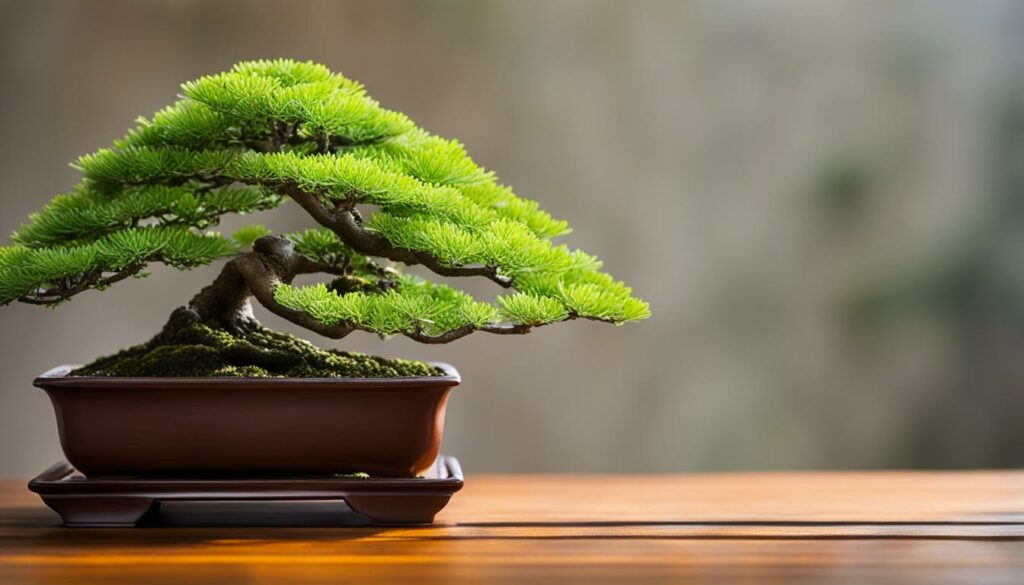
Key Takeaways:
- The Sageretia Theezans bonsai tree is a symbol of peace, harmony, and tranquility in Chinese culture.
- Its delicate white flowers and elegant form make it a popular choice for indoor bonsai enthusiasts.
- With proper care, the Sageretia Theezans can thrive in your indoor oasis, providing beauty and serenity for years to come.
Tips for Displaying and Caring for Your Sageretia Theezans
Displaying your Sageretia Theezans bonsai tree is an art form in itself. Here are some expert tips to enhance its visual appeal and ensure its long-term vitality:
Choose the Right Pot
Select a pot that complements the elegant form of your Sageretia Theezans bonsai tree. Make sure it has good drainage holes to prevent waterlogging, which can harm the roots. Repot your bonsai tree every two years to keep it healthy and support new growth.
Positioning Your Bonsai Tree
Sageretia Theezans bonsai trees require bright, indirect light. Place your bonsai near a south-facing or west-facing window for optimum sunlight exposure. Keep it away from air conditioning and heating vents, which can affect the temperature and cause dryness.
Watering Your Bonsai Tree
Water your Sageretia Theezans bonsai tree when the soil’s surface is dry to the touch. Use non-chlorinated, room-temperature water to avoid shocking the roots. Do not let the soil become too dry or too wet, as this can affect the tree’s health.
Pruning and Shaping Your Bonsai Tree
Prune your Sageretia Theezans bonsai tree regularly to encourage bushy growth and maintain its shape. Use sharp scissors to cut back new growth to two or three leaves. Wiring can be used to shape the branches and trunk, but be careful not to damage the bark.
Fertilizing Your Bonsai Tree
Apply a balanced, liquid fertilizer every two weeks during the growing season. Use half the recommended dosage to prevent over-fertilizing, which can lead to root burn. Stop fertilizing your bonsai tree during the winter months.
By following these tips, you can ensure the long-term health and vitality of your Sageretia Theezans bonsai tree, creating a beautiful and serene addition to your indoor oasis.
Sageretia Theezans: A Rewarding Bonsai Tree Species
As a bonsai enthusiast, growing the Sageretia Theezans is a fulfilling experience that brings joy and satisfaction. This bonsai tree species has a unique charm that sets it apart, with its delicate leaves and beautiful white flowers. With its graceful growth habit, the Chinese sweet plum is a great addition to any indoor bonsai garden. Taking good care of your Sageretia Theezans is a way to appreciate its beauty and ensure its long-term health.
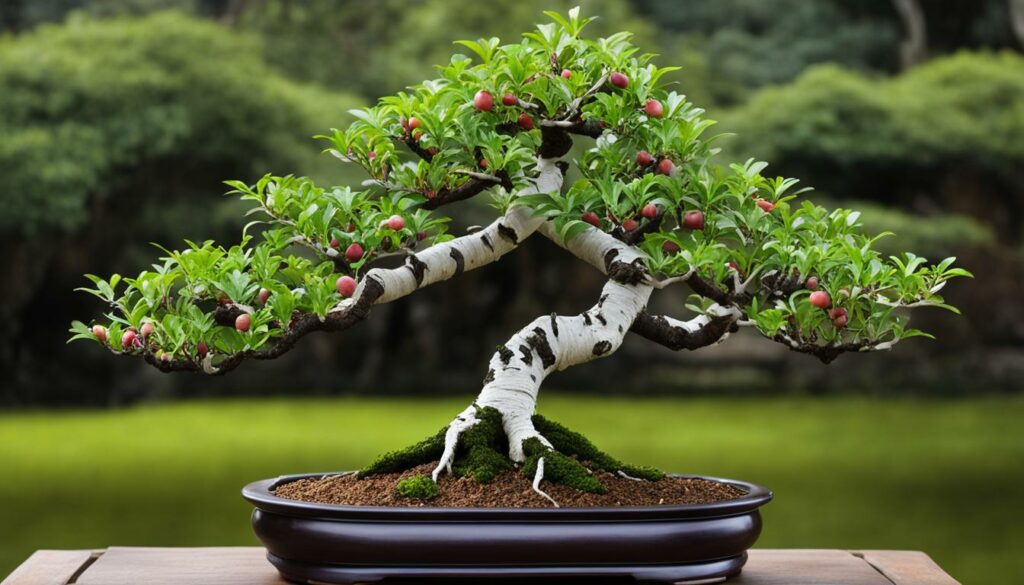
By learning the essential Sageretia care tips, you can keep your bonsai tree healthy and thriving. From selecting the right location to fertilizing, pruning, and shaping, your care goes a long way in maintaining its elegant form. With proper watering and humidity, you can ensure that your Sageretia Theezans bonsai tree remains healthy and vibrant.
The beauty of the Sageretia Theezans is not only in its physical form but also in its symbolism. This bonsai tree species represents peace, harmony, and tranquility, making it a perfect addition to any home or office. Displaying your Sageretia Theezans in a prominent location is a way to showcase its refined beauty and appreciate the rewards of growing this bonsai tree species.
Conclusion
Cultivating a Sageretia Theezans bonsai tree is a rewarding experience that can bring serenity and tranquility to your indoor space. By following the proper care techniques, you can enjoy the full potential of this remarkable bonsai tree species.
Remember to choose the right location for your Sageretia Theezans, ensuring that it receives the appropriate amount of light, temperature, and humidity. Take care to water and fertilize it regularly, and prune and shape it to maintain its elegant form.
If you encounter any pests or diseases, be sure to address them promptly to keep your Sageretia Theezans healthy and thriving. Display your bonsai tree with pride, knowing that it represents peace and harmony.
Whether you’re a seasoned bonsai enthusiast or just starting, the Sageretia Theezans is a bonsai tree species that can bring joy and satisfaction to all who cultivate it.
FAQ
What is the Sageretia Theezans bonsai tree?
The Sageretia Theezans, also known as the Chinese sweet plum, is a bonsai tree species valued for its beauty and elegance. It is a popular choice among bonsai enthusiasts for its graceful growth habit, small leaves, and delicate white flowers.
How to care for Sageretia Theezans indoors?
To care for Sageretia Theezans bonsai trees indoors, you need to ensure they receive adequate light, preferably by placing them near a south-facing window. Maintain optimal humidity levels by using a humidity tray or misting the leaves regularly. Water the bonsai tree when the topsoil feels slightly dry and prune it regularly to maintain its desired shape and size.
What is the ideal location for Sageretia Theezans bonsai trees?
Sageretia Theezans bonsai trees thrive in well-lit areas with indirect sunlight. They prefer temperatures between 65°F and 75°F (18°C to 24°C) and moderate humidity levels. Avoid placing them near drafts or extreme temperature changes, such as near heaters or air conditioning units.
How often should I water my Sageretia Theezans bonsai tree?
The watering frequency for Sageretia Theezans bonsai trees depends on various factors, such as temperature, humidity, and pot size. As a general rule, water the bonsai tree when the topsoil feels slightly dry to the touch. Avoid overwatering, which can lead to root rot, and ensure proper drainage by using well-draining soil.
How do I prune and shape my Sageretia Theezans bonsai tree?
Pruning and shaping your Sageretia Theezans bonsai tree is vital to maintain its elegant form and encourage compact growth. Use sharp, clean bonsai scissors or shears to remove unwanted branches and foliage. Aim to create a balanced and aesthetically pleasing shape, while ensuring some new growth is left to promote health and vigour.
What fertilizer should I use for my Sageretia Theezans bonsai tree?
When fertilizing your Sageretia Theezans bonsai tree, use a balanced, slow-release fertilizer designed specifically for bonsai trees. Follow the manufacturer’s instructions for application rates and frequencies. Fertilize the bonsai tree during the growing season, from spring to fall, and reduce or suspend fertilization during the dormant winter period.
How do I prevent and treat pests and diseases on my Sageretia Theezans bonsai tree?
To prevent pests and diseases, provide proper care and maintenance to your Sageretia Theezans bonsai tree. Regularly inspect the foliage and roots for signs of pests, such as aphids or spider mites. If detected, treat them with appropriate insecticides or miticides. Avoid overwatering and ensure good air circulation to minimize the risk of fungal diseases.
What does the Sageretia Theezans bonsai tree symbolize?
The Sageretia Theezans bonsai tree is often associated with peace, harmony, and tranquility. It represents a serene and tranquil presence, making it a popular choice for indoor bonsai displays. Many appreciate its graceful nature and use it as a symbol of inner peace and balance.
How should I display and care for my Sageretia Theezans bonsai tree?
Display your Sageretia Theezans bonsai tree in a prominent but protected location, away from direct sunlight and harsh drafts. Use a bonsai tray or stand to elevate its visual impact. Provide regular care by ensuring proper watering, humidity levels, and maintaining its desired shape through pruning and shaping.
What are the rewards of cultivating Sageretia Theezans bonsai trees?
Cultivating Sageretia Theezans bonsai trees can be a rewarding experience for bonsai enthusiasts. It allows you to witness and nurture the growth of a beautiful and elegant bonsai tree species. The art of caring for the tree and shaping its form can bring joy, satisfaction, and a deeper appreciation for nature’s beauty.
